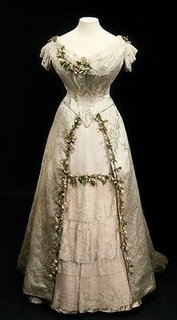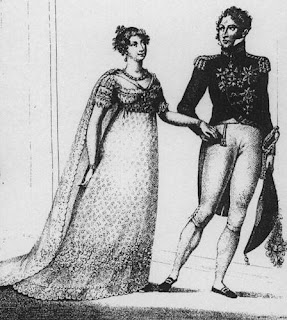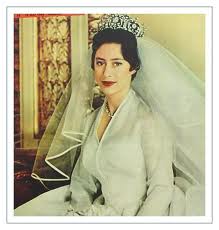Category: Queen Victoria
THE DEATH OF WILLIAM IV
William IV, the Sailor King, died on 20 June 1837. He was the third son of George III and younger brother and successor to George IV and was the last king and penultimate monarch of the House of Hanover. While William’s reign was much more sedate than that of his brother, George IV, with less scandal and spending and more attention being paid the business of running the country, William IV did have one bane to his existence – his sister-in-law the Duchess of Kent, mother to Princess Victoria.
King William’s problems with the Duchess began early in his reign – in fact, at his coronation, as related in a book called When William IV was King By John Ashton:
During the procession to the Abbey (for the Coronation of William IV) the weather was fine, and the sight a brilliant one; but, soon after one o’clock, a very heavy rain descended ; the wind, too, blew with great violence, and occasioned rattling and tearing among the canvas canopies of the newly erected stands. It ceased for a short time, between two and three, when it broke out afresh, and was particularly lively when the ceremony was over, at half-past three. It quite spoilt the return procession, some of the carriages driving straight away, and those that fell into rank had their windows up.
In spite of the weather, London was brilliantly illuminated, and the theatres and Vauxhall Gardens were thrown open free. There was a display of fireworks in Hyde Park, at which many were more or less hurt by the falling rocket-sticks, six so seriously as to have to be taken to St. George’s Hospital. Throughout the country the festivity was universal. One little thing marred the universality. The Duchess of Kent was not present at the coronation, neither was the Princess Victoria. It was an open secret that the King and the Duchess were not on friendly terms, but it was thought very bad taste on her part not to be present.
Though more contretemps between the King and the Duchess were to come (as will be shown in future posts), for the time being, all was well in the land. In his Memoirs, Charles Greville included the following entry for July 18th.— King George had not been dead three days before everybody discovered that he was no loss, and King William a great gain. Certainly nobody ever was less regretted than the late King, and the breath was hardly out of his body before the press burst forth in full cry against him, and raked up all his vices, follies, and misdeeds, which were numerous and glaring enough.
The new King began very well. Everybody expected he would keep the Ministers in office, but he threw himself into the arms of the Duke of Wellington with the strongest expressions of confidence and esteem. He proposed to all the Household, as well as to the members of Government, to keep their places, which they all did except Lord Conyngham and the Duke of Montrose. He soon after, however, dismissed most of the equerries, that he might fill their places with the members of his own family. Of course such a King wanted not due praise, and plenty of anecdotes were raked up of his former generosities and kindnesses. His first speech to the. Council was well enough given, but his burlesque character began even then to show itself. Nobody expected from him much real grief, and he does not seem to know how to act it consistently; he spoke of his brother with all the semblance of feeling, and in a tone of voice properly softened and subdued, but just afterward, when they gave him the pen to sign the declaration, he said, in his usual tone, “This is a damned bad pen you have given me.” My worthy colleague, Mr. James Buller, began to swear Privy Councillors in the name of “King George IV.—William, I mean,” to the great diversion of the Council.
A few days after my return I was sworn in, all the Ministers and some others being present. His Majesty presided very decently, and looked like a respectable old admiral. The Duke [of Wellington] told me he was delighted with him— “If I had been able to deal with my late master as I do with my present, I should have got on much better”—that he was so reasonable and tractable, and that he had done more business with him in ten minutes than with the other in as many days.”
HAPPY BIRTHDAY TO QUEEN VICTORIA – 24 May 1819
Above, Artist Sir George Hayter (1792-1871) also painted Victoria in her coronation robes. The ceremony took place on June 28, 1938, about a year after Victoria became Queen at age 18 after the death of her uncle, William IV (1765-1937).
Victoria was Queen until her death in 1901, the longest reign in English history at the time. The Hayter painting is in the National Collection in Britain and a copy of it hangs in the National Portrait Gallery, London.
Victoria’s name became the title of an age characterized by a revolution in industry, transportation, communication, medicine, culture, and, perhaps, family relationships and sexual behavior. At the beginning of her reign, horses and sailing ships provided transportation. At the end of her life, we had dirigibles and the Wright Brothers first flew just a couple of years later. Wonder what Victoria would have thought of blogging?
In celebration of the 200th Anniversary of Queen Victoria’s birth this year, Number One London Tour will be exploring all aspects of the Queen’s life, from her birth at Kensington Palace to her death in 1901 at Osborn House on the Isle of Wight, on our 2019 Queen Victoria Tour. Full details and Tour itinerary can be found here.
A BIRTHDAY LETTER FROM KING LEOPOLD

ROYAL WEDDING GOWNS
by Victoria Hinshaw
Originally posted on February 12, 2011, ahead of the other wedding of the decade, that of William and Katherine.
As I write this, there is no word on the designer Kate Middleton has chosen to create her wedding gown, though I have heard many breathless accounts of who is and who is not in the running. So let’s indulge our royal wedding mania by looking at some of the gowns worn in the past.
Above is the dress worn by Princess Charlotte of Wales at her May 2, 1816, wedding to Prince Leopold of Saxe-Coburg, as exhibited in the Museum of London here.
At right, an image of Queen Victoria’s dress on a mannequin in the collection of Kensington Palace.
Left, the wedding gown of Alexandra of Denmark, who married Victoria’s son, eventually King Edward VII, on March 10, 1863 in St. George’s Chapel at Windsor Castle. She was Princess of Wales for almost forty years before becoming Queen in 1901. After her husband’s death in 1910, she was known as the Queen Mother until she died in 1925.
Like Charlotte’s mother, Caroline, Princess of Wales, and like the first wife of the present Prince of Wales, Diana (see below), Alexandra had to endure the infidelity of her husband. But unlike the other two, she stuck with him to the end. We’ve all heard the possibly-apocryphal story about how Alexandra invited one of his mistresses, Alice Keppel, to comfort Edward VII on his deathbed.
 Princess Mary of Teck wed Prince George, Duke of York on 6 July, 1893 in the Chapel Royal of St. James Palace. She had been engaged to Prince Albert Victor, eldest son of the Prince of Wales in 1891, but Albert Victor died in the great influenza epidemic of 1891-92. Mary and George fell in love and were married with the approval of Queen Victoria as well as Edward and Alexandra, Prince and Princess of Wales. George succeeded his father as George V in 1910. Queen Mary, who was a godchild of Queen Victoria, had five sons and one daughter.
Princess Mary of Teck wed Prince George, Duke of York on 6 July, 1893 in the Chapel Royal of St. James Palace. She had been engaged to Prince Albert Victor, eldest son of the Prince of Wales in 1891, but Albert Victor died in the great influenza epidemic of 1891-92. Mary and George fell in love and were married with the approval of Queen Victoria as well as Edward and Alexandra, Prince and Princess of Wales. George succeeded his father as George V in 1910. Queen Mary, who was a godchild of Queen Victoria, had five sons and one daughter.Her eldest son, known to all as David, was more than a disappointment. After inheriting the throne as Eward VIII in 1936, he abdicated less than a year later to marry Wallis Simpson.
After her husband’s death, Queen Mary chose to be addressed as Her Majesty, Queen Mary, rather than as Queen Mother. She was very supportive of her second son, who became King George VI after his brother’s departure from the throne. According to several sources, she was the first dowager queen of Great Britain to ever attended the coronation ceremony of her husband’s successor.
As Duke of York, the second son of George V and Mary grew up in the shadow of his dashing older brother. He married Lady Elizabeth Bowes-Lyon on 26 April 1923 in Westminster Abbey. At the time of the wedding, it was not expected that “Bertie” would take the throne. Lady Elizabeth’s gown, perhaps for that reason, was not as elaborate as some of her predecessors. It was certainly in the style of the day, a rather loose gown, slightly less than floor length. Below is the dress on a mannequin in a Kensington Palace exhibition of several years ago, along with a detail of the veil and bodice.
Princess Margaret, second daughter of King George VI, married Antony Armstrong-Jones (later Earl of Snowdon) on May 6, 1960, at Westminster Abbey. Television cameras covered the event and the broadcast was seen worldwide. Like her sister, Margaret chose Norman Hartnell to design her bridal gown.The couple had two children: David, Viscount Linley in 1961 and Lady Sarah Armstrong-Jones in 1964. The Snowdons were divorced in 1978 and Princess Margaret died in 2002.
14 November 1973 – Anne, Princess Royal, married Captain Mark Phillips in Westminster Abbey. Born in 1950, she is Queen Elizabeth II’s only daughter. Anne and Phillips have two children, Peter Phillips born in 1977 and Zara Phillips born in 1981. After divorcing Phillips in 1992, Anne married Timothy Laurence, in Scotland on December 12, 1992.
On 29 July 1981, Lady Diana Spencer and Charles, Prince of Wales, were married in St Paul’s Cathedral. Her dress was controversial — and still is. The designers, David and Elizabeth Emmanuel, immediately shot to the top echelon of British fashion. Like many of Diana’s fashions, the gown (or a replica) travels around the world for popular exhibition.
Charles and Diana had two sons, Prince William, born in 1982, and Prince Harry, born in 1984, before separating
in the late 1980s, the Prince living in Highgrove and the Princess at Kensington Palace. Formal separation came in 1992 and the marriage of Charles and Diana ended in divorce on 28 August 1996. On 31 August 1997, a year after the Prince and Princess divorced, Diana died in a car crash in Paris.
Sarah Ferguson and Prince Andrew, the Duke of York, married at Westminster Abbey on 23 July 1986. The Duke and Duchess of York had two children during their marriage: Princess Beatrice of York (born 1988) and Princess Eugenie of York (born 1990). They separated in 1992 and divorced in 1996, though they are often together for vacations and family events.


Of all the gowns shown above, I think I like Sarah’s best, as designed by Lindka Cierach. It is beautiful, flattering to her and has no gimmicks. Princess Elizabeth’s was lovely too, but I like Sarah’s veil better. All in all this one is the winner in the gown category, if perhaps not in the list of “most suitable royal brides.”
If like us, you can’t get enough of this wedding stuff, here is a wonderful exhibition from the Royal Collection you will enjoy.




















